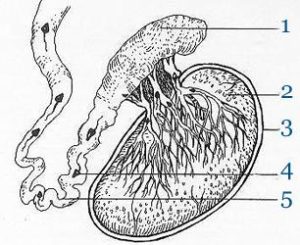Infertility


MEN
Infertility in men is defined as the inability to impregnate a woman after one year of regular sexual intercourse due to a number of reasons including spermatogenesis abnormalities.
Sperm is produced in the seminiferous tubules of the testicles. Like tadpoles, the spermatozoon moves by propulsion or the thrusting movement of the tail. The young sperm passes through a convoluted tube called epididymis towards the vas deferens where it matures. It has a life span of about three weeks. A normal semen analysis should contain more than 20 million sperm per ml with a motility rate of greater than 75%. Usually, a sperm count or rate of motility that falls below these parameters results in failed pregnancies.

- EPIDIDYMIS
- SEMINIFEROUS TUBULES
- TESTICLE
- SPERM
- VAS DEFERENS
As the spermatozoa enter the vaginal canal, it proceeds to the uterine cavity through the cervical canal and must reach the ovum in the fallopian tubes where fertilization of the egg occurs. Any disruption in these events may result in infertility.
Infections – A Cause of Infertility
Infections can cause abnormalities in the production of sperm, or cause an obstruction in the passageway, or affect the sperm itself.
Alexander and Berger wrote: “The belief that inflammation and infection in the male genital tract can adversely affect fertility is widely held.” A trend towards a decreasing sperm count in men has been observed from 1934 and may be related to the increasing incidence of these infections in men.
For example, Gonorrhea and Chlamydia, silent as they are, can trigger a potentially sterilizing infection of the testicles and epididymis, and rarely, the vas deferens. Other bacteria such as the Chlamydia trachomatis, Ureaplasma urealyticum and Mycoplasma hominis may colonize the tail of the sperm; or some coliforms and even the fungus called Candida Albicans may cause agglutination of sperm, reducing its motility and killing them (Colleen and Mardh).
Additionally, Brown observed phagocytosis (ingestion) of sperm by Trichomonas vaginalis (a protozoan) and other investigators (Krieger) have noted that sperm mobility is decreased in the presence of large numbers of Trichomonas vaginalis in vitro.
WOMEN
A woman is infertile if she fails to become pregnant after one year of regular sexual intercourse and her husband has a normal sperm analysis.
A woman of any age, still menstruating, may become pregnant. Generally, the maximum potential is up to the age of 25 years, and after that, fertility steadily declines with a sharp drop after 30 years of age.

- FERTILIZED EGG (OVUM)
- IMPLANTED EGG
- OVULATION
- OVARY
- SPERM
- VAGINA
The ovum or egg of the woman is produced by the ovaries. The woman produces an egg, or ovulates, once a month around mid-cycle of a menstrual period.
After each menstrual flow, the uterus will begin to form a suitable lining or crib to cradle a fertilized egg. If fertilization does not occur, the uterus will shed this lining, resulting in menstruation, and the process starts all over again. This building up and shedding, as well as ovulation, is hormonally controlled. An unbalanced hormone production interferes with this process and infertility results.
On the other hand, a mature egg or ovum travels to the fallopian tubes where fertilization takes place. The egg slides down to the uterus where it lodges in the prepared crib and develops into a fetus. Forty weeks later, the fetus is expelled to become a new born infant and joy to its parents.
Many Are Childless Due to Infection
In the Philippines, 1 out of 4 married young couples are now childless, or may have fewer children than they desire. For many of them, it is due to a reversible infection of the genital tract. In the United States, 15% of married couples are involuntarily childless and another 10% may have fewer children than they desire.
Some bacteria may colonize the sperm and be transported to the fallopian tubes and cause a scarring infection resulting in blockage of the tubes, as well as infection of the lining of the uterus, preventing a fertilized egg from being implanted.
Men
The examination of infertile men begins with complete laboratory tests for genitourinary tract infections whether or not they are symptomatic. Sperm analysis is also done.
A most important point is to educate the partners on all aspects of infertility to ensure their cooperation. Instruction materials are presented to encourage doctor-and-patient interaction.
After the infection is treated or ruled out as the cause of infertility and the sperm count and/or motility persist to be abnormal, hormonal studies are also done, including biopsy of the testicles, to determine if the problem is in the production of sperm. The patency of the fallopian tubes are also ascertained.
Women
The examination of infertile women begins with counseling regarding all aspects of infertility. With or without signs and symptoms of a genitourinary tract infection, complete laboratory tests are done and any infection is eradicated.
The woman is instructed on body basal temperature to indicate if she is ovulating and when it occurs. The lifespan of an ovum is approximately 24 hours after it is expelled from the ovary. Hormonal studies are also done and corrected if there is a deficiency. Elevated levels of prolactin produced by the pituitary can cause infertility in both sexes and can be blocked by a drug called bromocriptine (Parlodel). Fertility pills such as ‘Clomiphene citrate’ marketed under the brand name ‘Clomid,’ is only given to a woman after it is determined that she is not ovulating, her tubes are patent, and her husband’s sperm analysis is normal.